
Swithun was an Anglo-Saxon bishop of Winchester and subsequently patron saint of Winchester Cathedral. His historical importance as bishop is overshadowed by his reputation for posthumous miracle-working. According to tradition, if it rains on Saint Swithun's bridge (Winchester) on his feast day it will continue for forty days. The name was originally spelt Swithhun.

Saint Margaret of Scotland, also known as Margaret of Wessex, was an English princess and a Scottish queen. Margaret was sometimes called "The Pearl of Scotland". Born in the Kingdom of Hungary to the expatriate English prince Edward the Exile, Margaret and her family returned to England in 1057. Following the death of king Harold II at the Battle of Hastings in 1066, her brother Edgar Ætheling was elected as King of England but never crowned. After she and her family fled north, Margaret married Malcolm III of Scotland by the end of 1070.

Ame-no-Uzume-no-mikoto is the goddess of dawn, mirth, meditation, revelry and the arts in the Shinto religion of Japan, and the wife of fellow-god Sarutahiko Ōkami. She famously relates to the tale of the missing sun deity, Amaterasu Omikami. Her name can also be pronounced as Ama-no-Uzume. She is also known as Ōmiyanome-no-ōkami, an inari kami possibly due to her relationship with her husband.

Blaise of Sebasle was a physician and bishop of Sebastea in historical Armenia who is venerated as a Christian saint and martyr.

Jude was one of the Twelve Apostles of Jesus according to the New Testament. He is generally identified with Thaddeus, and is also variously called Jude of James, Jude Thaddaeus, Judas Thaddaeus or Lebbaeus. He is sometimes identified with Jude, the brother of Jesus, but is clearly distinguished from Judas Iscariot, the apostle who betrayed Jesus prior to his crucifixion. Catholic writer Michal Hunt suggests that Judas Thaddaeus became known as Jude after early translators of the New Testament from Greek into English sought to distinguish him from Judas Iscariot and subsequently abbreviated his forename. Most versions of the New Testament in languages other than English and French refer to Judas and Jude by the same name.
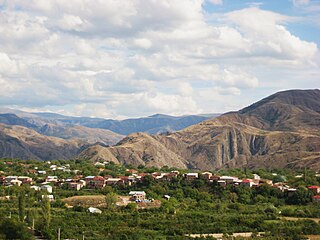
Garni, is a major village in the Kotayk Province of Armenia. It is known for the nearby classical temple. As of the 2011 census, the population of the village is 6,910.

Church of the Sepulchre of Saint Mary, also Tomb of the Virgin Mary, is a Christian tomb in the Kidron Valley – at the foot of Mount of Olives, in Jerusalem – believed by Eastern Christians to be the burial place of Mary, the mother of Jesus. The Status Quo, a 250-year old understanding between religious communities, applies to the site.

Thecla or Tecla was a saint of the early Christian Church, and a reported follower of Paul the Apostle. The earliest record of her life comes from the ancient apocryphal Acts of Paul and Thecla.
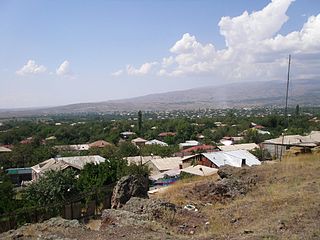
Oshakan is a major village in the Aragatsotn Province of Armenia located 8 kilometers southwest from Ashtarak. It is well known to historians and pilgrims of the Armenian Apostolic Church as the site of the grave of Mesrop Mashtots, the inventor of the Armenian alphabet.
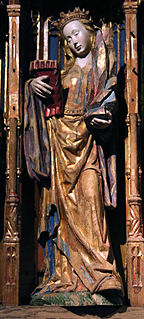
Saint Sunniva is the patron saint of the Norwegian Diocese of Bjørgvin, as well as all of Western Norway.

Saint Pantaleon, counted in the West among the late-medieval Fourteen Holy Helpers and in the East as one of the Holy Unmercenary Healers, was a martyr of Nicomedia in Bithynia during the Diocletianic Persecution of 305 AD.
Saint Aurea or Oria (1043-1070), was a Spanish anchorite saint attached to the Monastery of San Millán de la Cogolla, in the Spanish Province of La Rioja (Europe). She is commemorated on 11 March.
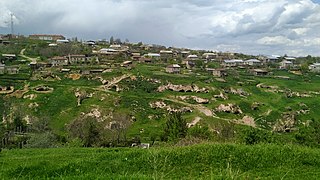
Tegh is a village and rural community (municipality) in the Syunik Province of Armenia. The Statistical Committee of Armenia reported its population was 2,520 in 2010, up from 2,333 at the 2001 census.

Karmrashen, known as Kirmizlu until 1946, is a village in the northern part of the Aragatsotn Province of Armenia. The village is home to the Saint Astvatsatsin Church of 1865, a rock cut shrine, ruins of a fortress, and several khachkars.
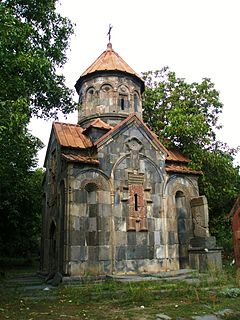
Mashtots Hayrapet is a church located within the village of Garni in the Kotayk Province of Armenia. It was built in the 12th century at the site of what was a pagan shrine. A stone carved from red tufa is situated at the right of the entrance upon a low rock wall. It has on it the design of a bird perched on a floral stem with the rosette of eternity under its tail. The rosette is also a distinctive pagan symbol representing the sun or the moon, symbolizing the eternal cycle of life, death, and rebirth. It is said that because of this pagan symbology, this stone has a connection to the prior shrine.
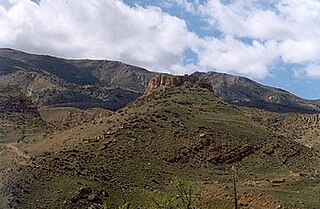
Ertij is a fort built during the 13th century. It is situated upon a hill adjacent to the village of Arpi in the Vayots Dzor Province of Armenia. Nearby in the gorge carved by the Arpa River is the cave shrine of Jrovank.

Aya Tekla Church, also known as Aya Thecla or Aya Thekla, is a ruined historic church of the Byzantine period. It was a popular pilgrimage site, and still attracts visitors today.
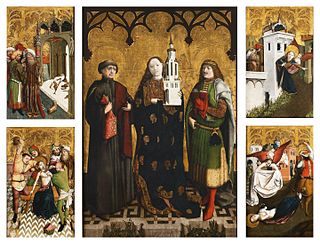
Saint Barbara, , known in the Eastern Orthodox Church as the Great Martyr Barbara, was an early Christian Lebanese and Greek saint and martyr. Accounts place her in the 3rd century in Heliopolis Phoenicia, present-day Baalbek, Lebanon. There is no reference to her in the authentic early Christian writings nor in the original recension of Saint Jerome's martyrology. Despite the legends detailing her story, the earliest references to her supposed 3rd century life do not appear until the 7th century, and veneration of her was common, especially in the East, from the 9th century.
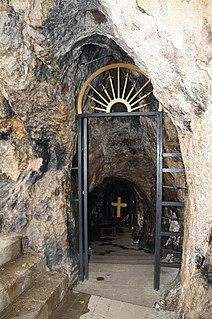
The Cave of Saint Blaise is a small cave in Laç, Albania. It is thought to have been the place where Saint Blaise lived, and remains a popular pilgrimage site.





















